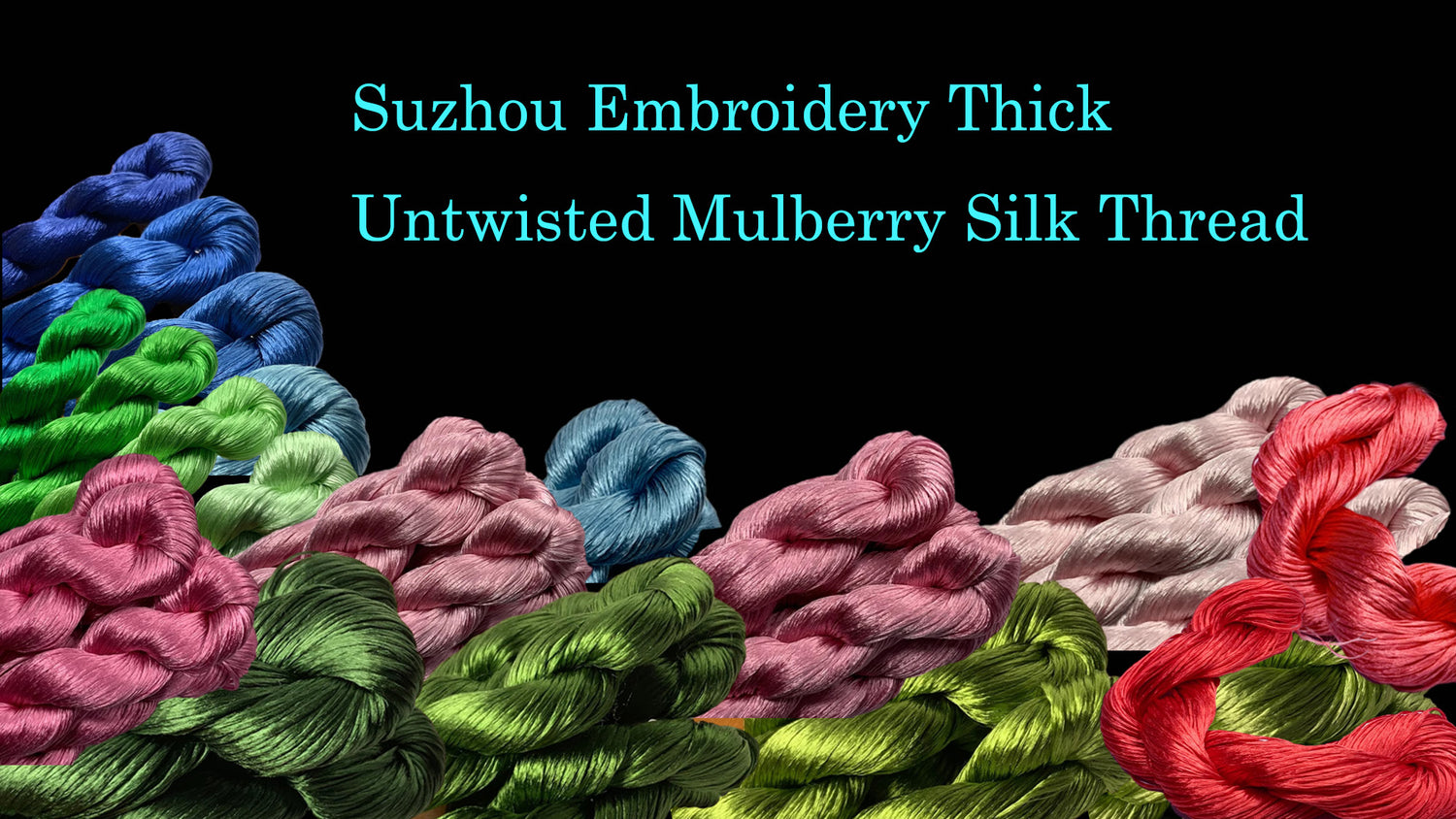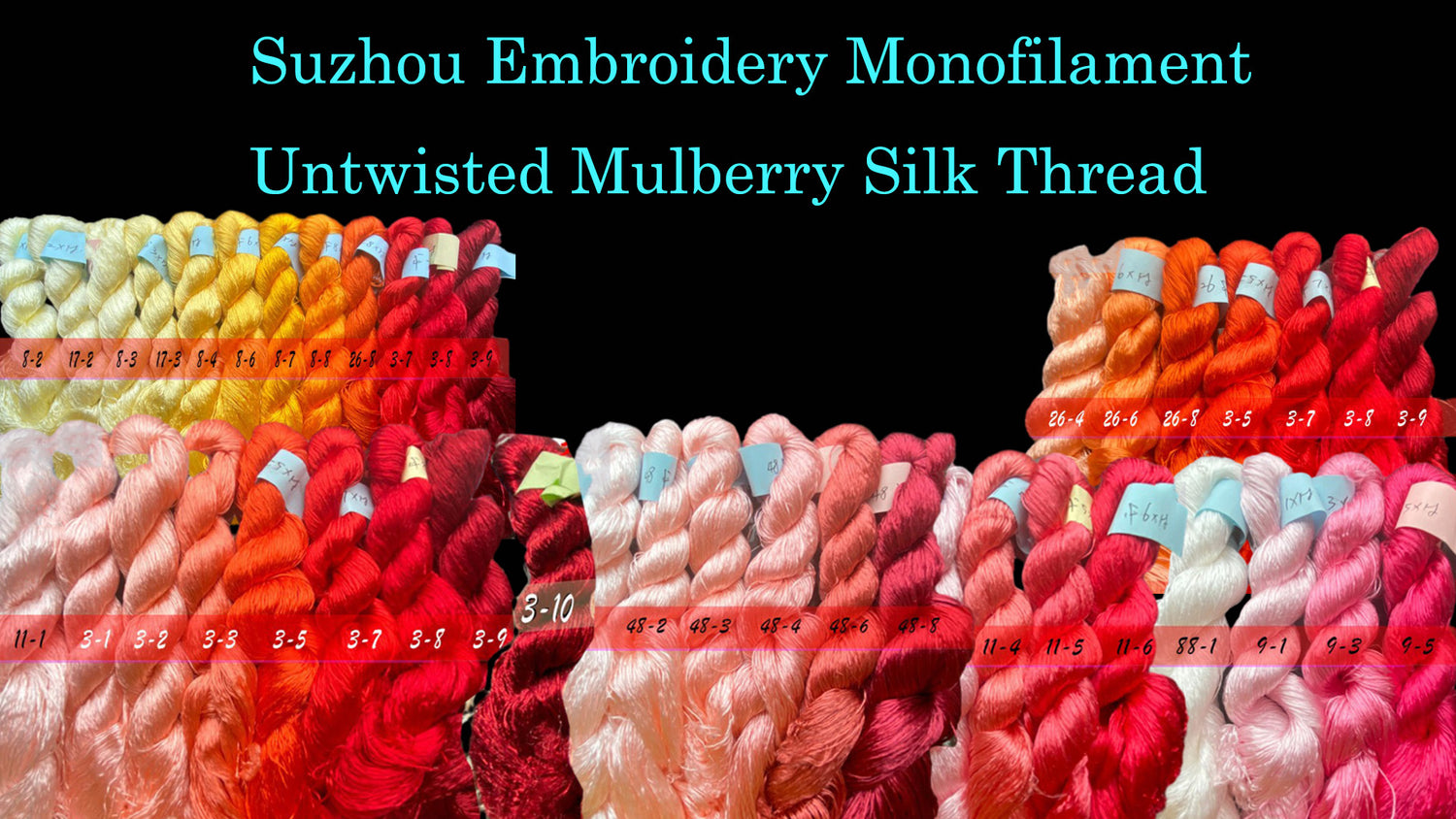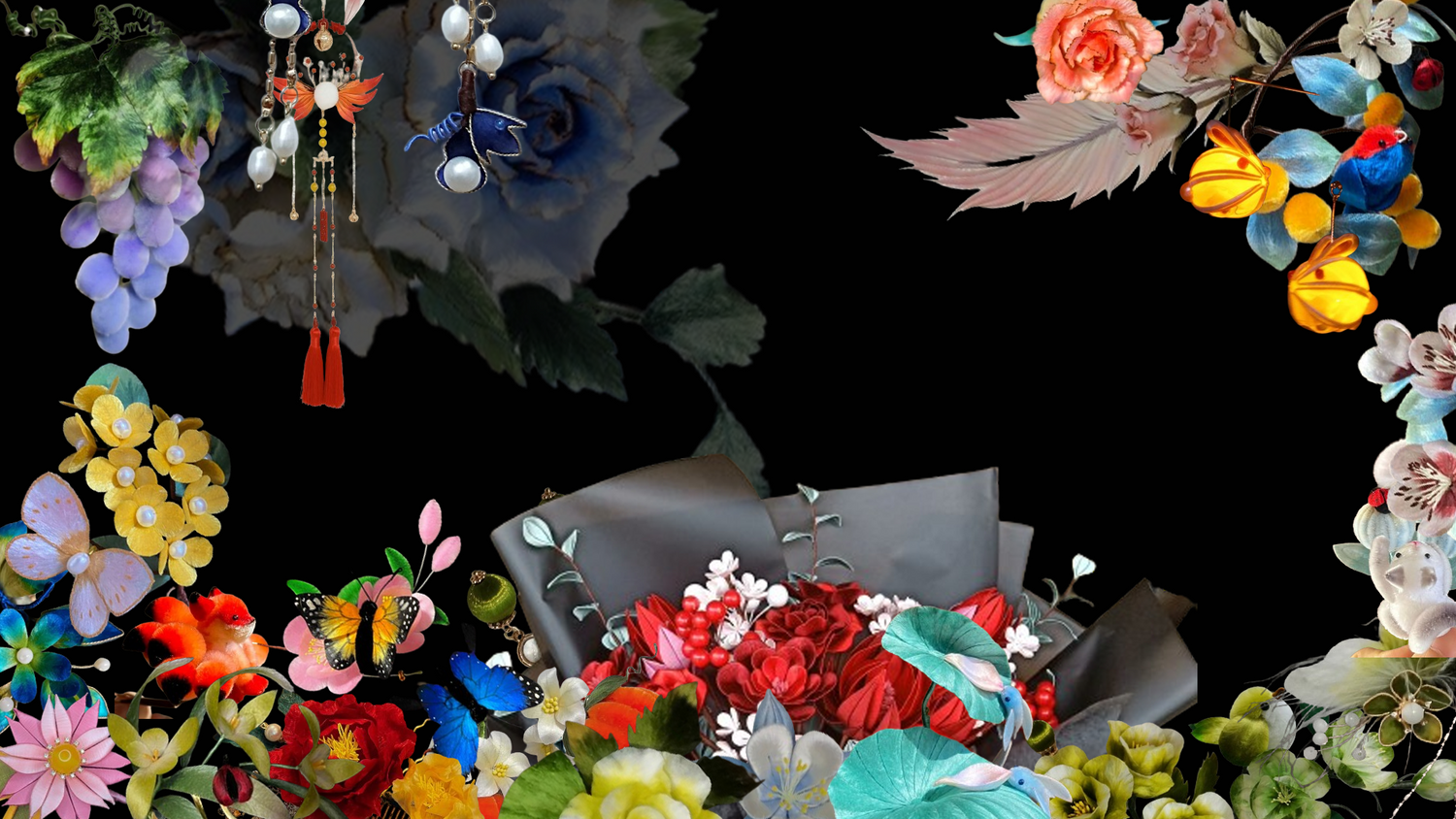
How to Make a Butterfly and Flower Chanhua Hairpin
Share
5.1.1. Making Gradient Flowers
The winding method for gradient flowers is the same as previously mentioned, but different flower shapes require different drawing techniques.
A. Materials and Tools:
White card paper, carbon pen, scissors, 30-gauge wire for mesh flowers, silk threads, a bowl of clean water, a brush, red dye, paper towels, round wax thread, white glue, round-nose pliers, chopsticks, a lighter, finished copper flower stamen, handmade pliers, decorative pearls.
B. Making the Flowers
 1
1
1. Use the carbon pen to draw a five-petal flower pattern on the white card paper. Ensure the shape is rounded and symmetrical. Cut along the lines with scissors, cutting each petal into two halves, resulting in 5 sets of 10 pieces of card paper.
 2
2
2. Take a suitable length of wire, bend one end to about 12 cm, and start winding it with silk threads.
 3 4
3 4
3. Take a piece of half-petal card paper, align the narrow end with the start of the wire, place it on the wire, and hold it with your left hand to fix it. Wind the silk thread around the card paper with your right hand, creating a half-petal.
4. Take another half-petal card paper, join the ends together, ensuring no gaps in the middle. Bend the wire appropriately so that the petals align. Wind the silk thread to create a complete and symmetrical petal, then join the two petals to form a complete one.
 5
5
5. Wrap the silk thread into a loop and knot it through the entire petal 2-3 times for firmness.
 6 7
6 7
6. Bend the wire and add a new piece of card paper at the bend, using the same winding method to create the second petal.
7. Wrap and finish all 5 petals, leaving some silk thread for adjusting the overall flower distribution.
C. Dyeing
 1 2
1 2
1. Dip the brush in clean water and lightly brush both sides of the petals to wet them.
2. Add a small amount of red dye to the water. Use the brush to apply the dye unevenly on the petals, making some areas darker for a layered effect. Ensure the back side is also dyed. Carefully dab excess water with a paper towel. Let the small flowers dry after dyeing.
3. Use the same method to make 6 dyed small flowers.
D. Making Silk Thread Stamen Flowers and Stems
 1 2
1 2
1. Combine several round wax threads to form the stamen, then combine with a dyed small flower.
2. Wind the wire with silk threads to create the stem, applying some white glue at the bottom to fix the silk threads.
 3
3
3. Use round-nose pliers to twist the wire into a spring-like stem, ensuring consistent wire rotation.
 4 5 6
4 5 6
4. Press the rounded end of the chopsticks against the petal to bend it, making it look more natural.
5. Carefully singe the stamen with a lighter to form a rounded tip, completing the silk thread stamen flower.
6. Make 3 silk thread stamen flowers using the same method.
E. Making Copper Stamen Flowers
 1
1
1. Take a finished copper flower stamen, use handmade pliers to bend it, creating an uneven look.
 2 3
2 3
2. Take a piece of 30-gauge wire, thread it through a decorative pearl, gather the wire ends below the pearl, and thread it through the center of the copper stamen. Then thread it through the center of a dyed small flower.
3. Adjust the petal shape for a more natural look. Refer to steps 2 and 3 of the silk thread stamen flower-making process to create the stem for the copper stamen flower. Make 3 copper stamen flowers using the steps 1 and 2.
 4
4
4. Use silk threads to wrap the stems of the 3 silk thread stamen flowers and the 3 copper stamen flowers together.
5.1.2 Making the Butterfly Base
The butterfly base is the foundation of this Chanhua piece, forming a large butterfly shape with multiple overlapping wings. The top and bottom wings differ, so they need to be made separately. This section details the wing creation and overall assembly of the butterfly base.
A. Materials and Tools:
White card paper, carbon pen, scissors, 30-gauge wire for mesh flowers, light yellow and light green silk threads, white glue, decorative pearls.
B. Making the Upper Part
 1 2
1 2
1. Use the carbon pen to draw the upper wing pattern of the butterfly base on the white card paper, then cut out 8 pieces of card paper with scissors.
2. Take a suitable length of wire (longer than the perimeter of the wing with extra length), and wind it with split light yellow silk threads. Hold the end of the split thread and the wire end tightly with your left hand, and wind the thread clockwise from left to right around the wire with your right hand for about 1 cm.
 3
3
3. Take the card paper marked "1" and "2" from step 1 and wind it from "1" to "2".
 4
4
4. After winding, apply white glue to fix it and start with light yellow silk thread again.
 5
5
5. Take the card paper marked "3" and "4" from step 1, and wind the light yellow silk thread from "3" to "4".
 6
6
6. Combine the wound parts into a wing shape, and repeat the steps until all parts are wound.
 7 8
7 8
7. Wrap the leftover wire from the flower-making process with pink thread used for winding the stamen. Make 4 five-petal flowers with pearl stamens, 8 five-petal flowers with silk thread stamens, and combine them into 4 flower clusters. Each cluster contains 1 five-petal pearl stamen flower and 2 five-petal silk thread stamen flowers.
8. Insert a flower cluster into the hollow part of a larger wing, placing 1 five-petal pearl stamen flower below the wing and 2 five-petal silk thread stamen flowers above it. Hold the wing root and flower cluster stem tightly with your left hand.
 9
9
9. Place a smaller wing above the larger wing, still holding the root tightly, and wind it with silk threads to fix it.
10. Repeat steps 8 and 9 to complete the other side of the wing assembly.
C. Making the Lower Part
 1
1
1. Draw the pattern of the lower wings of the butterfly base on white card paper and cut out 6 pieces with scissors. The larger wings consist of two pieces of white card paper and are wound in the same way as the upper part.
 2
2
2. The winding order for the smaller wings is shown in the diagram. The silk threads should be wound radially, with slight overlap in the inner circle and evenly spread to the edges in the outer circle. Press down with the left middle finger after each winding to prevent the wound silk threads from slipping.
 3
3
3. Refer to steps 8, 9, and 10 of the upper part of the butterfly base assembly process to complete the assembly of the lower part of the butterfly base. The other wing is wound and assembled in the same way.
5.1.3 Overall Assembly
After the main parts are completed, the next step is to make the hairpin and complete the final overall assembly. This section will cover the assembly of the Chanhua hairpin and the making of decorative velvet balls.
A. Materials and Tools:
Lotus-colored and gold-colored silk threads, scissors, hard card paper, alcohol glue, 30-gauge wire for mesh flowers, handmade pliers, 2 cm diameter discs, brush, brown elastic thread, hairpin rod.
B. Making Velvet Ball Antennae
 1
1
1. Cut the lotus-colored silk thread and take a 2 cm wide piece of hard card paper. Cut a notch at one end of the card paper and wrap the silk thread around the card paper 8 times.
 2
2
2. Take a piece of 60 cm long wire, thread it through the notch inside the card paper, fold it outwards, making the silk thread bundle sit at the top of the wire. Fold the wire back on itself and twist tightly, then cut the silk threads along the "1 to 2" and "3 to 4" paths and trim any excess silk threads.
 3
3
3. Use handmade pliers to twist the wire inside the silk thread bundle tightly, ensuring the silk threads do not loosen or shift.
 4
4
4. Place a 2 cm diameter disc on the silk thread bundle, aligning the center of the disc with the top of the wire inside the velvet ball. Trim the length of the silk threads along the edge of the disc, then brush to fluff the threads and make the velvet ball neat and smooth.
 5
5
5. Wrap the wire with silk threads.
 6
6
6. Bend the wire into a spring shape using the copper hairpin rod, ensuring consistent curvature.
7. Refer to steps 1-6 to complete the second velvet ball antenna.
C. Assembling the Hairpin
 1 2
1 2
1. Use gold-colored silk thread to assemble and fix the upper and lower parts of the butterfly wings, starting with the lower part and then adding the upper part.
2. Add dyed small flowers to the center of the butterfly base, and finally add the velvet ball antennae, fixing each element in place.
 3
3
3. Wrap brown elastic thread around the root of the wire at the bottom of the butterfly base, winding downwards for about 1 cm. Thread the exposed wire through the hole at the bottom of the hairpin rod, continue winding downwards for another 1 cm to fix it, then tightly wind the wire and the hairpin rod together.
 4
4
4. Fold the wire back, ensuring it lies flat against the hairpin rod and wire, then wind the elastic thread upwards until the wire is completely covered. Apply alcohol glue to the hairpin rod to prevent the Chanhua from falling off. Gently bend the wire by hand to flip the Chanhua to the front of the hairpin.
 Finished Product Display
Finished Product Display









1 comment
Hermosisimo trabajo 😍😍😍